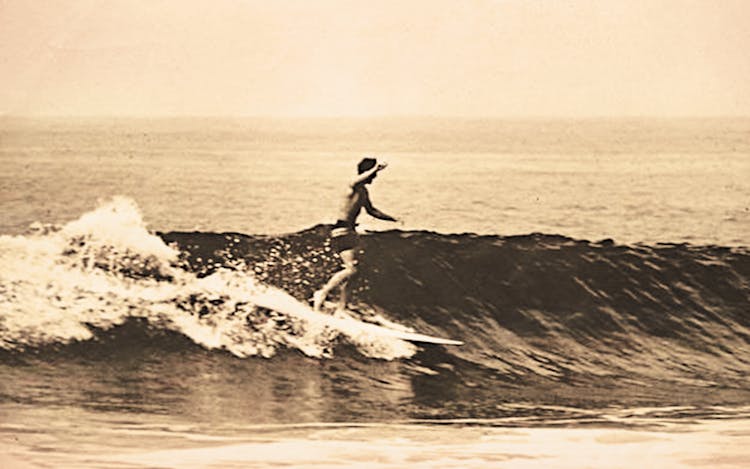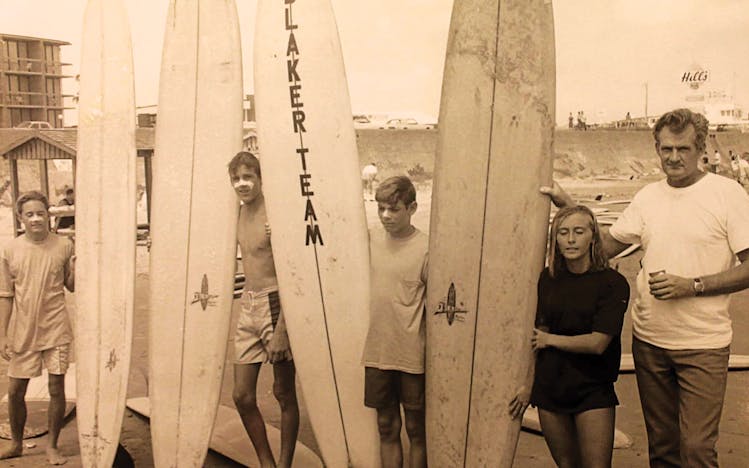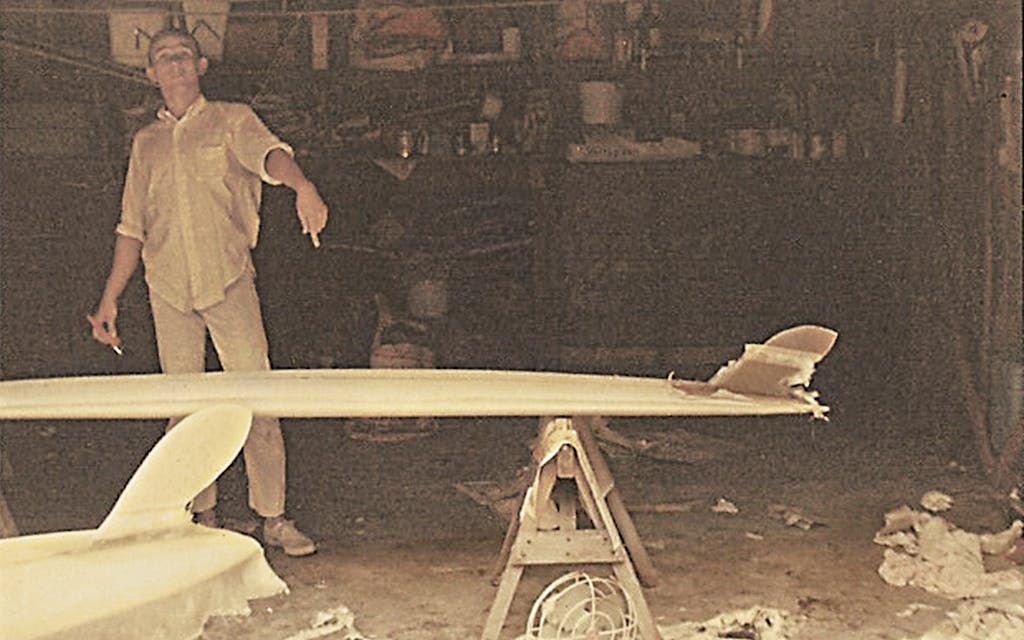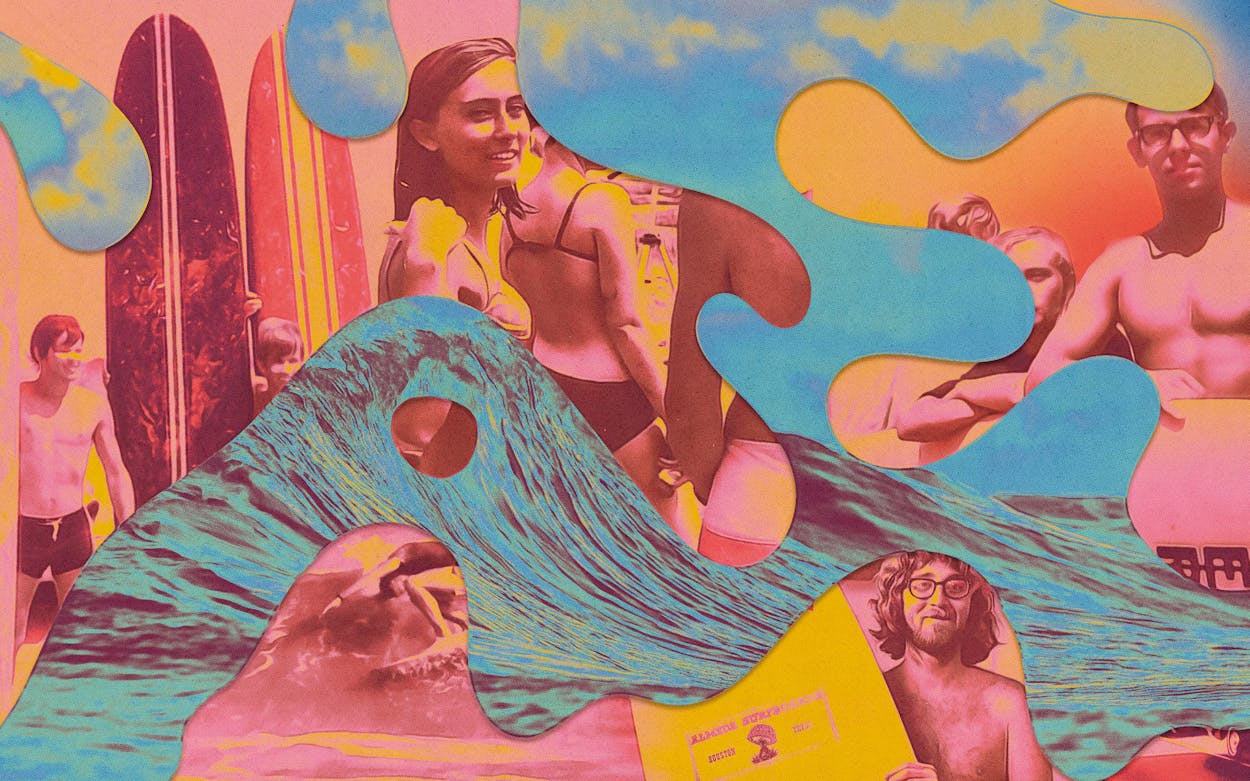Paddling a surfboard isn’t easy with an AARP card in one hand and a Medicare card in the other. A stiff neck and bad lower back don’t help either. But none of that stops me from once again strapping my longboard to the top of my Chevy Tahoe SUV and driving to Surfside Beach, about an hour south of where I live, in Houston, my seventy-sixth birthday in the rearview mirror. It’s an early spring morning, clear and crisp, with reports of solid waist-high waves—just the way I like them. I’ve been surfing on the Texas coast for almost sixty years. Much of this record was made possible by my almost four-decade-long career as an outdoor-sports columnist for the Houston Chronicle. When I started that job, fishing and hunting made up the traditional beat, but in 1972 I persuaded my editors to let me write the occasional feature on wave riding. I had been surfing since my teens and knew the Texas scene was worth covering. I was never an exceptional surfer, but I was legit. The Lone Star State boasts more than 360 miles of coastline, with barrier islands fronting the open Gulf of Mexico. A thriving wave-riding community has stretched from Galveston to South Padre Island since the sixties, when surfing entered mainstream culture through movies such as Ride the Wild Surf and The Endless Summer and hit songs from the Beach Boys and the Ventures. Although the scene isn’t as hot now, the Gulf Coast remains a year-round surfing destination. By 10 a.m. or so on a good day at Surfside, parking spaces along the one-mile Beach Drive and the jetty park are full.
The best waves in the state are off South Padre (too far for day trips from Houston, alas). The Gulf of Mexico can’t compare to the great oceans, but surfers here make the most of the typical thigh-to-chest wind swells. Texas surf is inconsistent, but one glorious truth remains: for those who patiently wait, Lady Luck and Old Man Gulf will return arm in arm to the beach party. And when well-formed waves are rising under sparkling sun, there’s not much that gets in the way of the frantic drive to the coast.
I retired from the Chronicle more than fifteen years ago. My flexible schedule as a freelancer allows me to head to Surfside or Galveston whenever the surf is up (I wear board shorts during the warm-water months, wet suits during winter). I usually travel solo these days—probably not a prudent plan, but surfing is a selfish pursuit. The act of leaving society behind and gliding with determined strokes into the sea, there to sit and wait for the advance of a mysterious pulse from beyond the horizon, encourages a loner spirit. Yet a strong bond exists among those of us haunted by waves. The friendships I’ve made with fellow surfers have been among my strongest and longest.
As I get on Texas Highway 288 and head toward Surfside, I don’t feel alone. The past keeps me company.


Instead of going directly to Surfside, as I usually do, this day I take a detour south of downtown Houston, suffering the gauntlet of red lights through the Almeda neighborhood for sentimental reasons. I am looking for the spot where Blaker’s Water Sports once stood, near the corner of Gumas Street and Almeda Road. The small building is long gone, so I don’t even bother getting out. Just driving past the area brings back a wave of memories. Or a memory of waves.
During spring 1964, when I was seventeen years old and just learning how to surf, the shop was owned and operated by Mack Blaker, who helped pioneer the Texas surfing market. He was in his mid-thirties and well over six feet tall, lanky and rangy, fit and tan; he resembled marshal Matt Dillon from Gunsmoke. An accomplished scuba diver and champion spearfisher, he was soft-spoken and mild-mannered. His positive aura made him a good influence on impressionable kids chasing a maverick lifestyle.
The surf shop was the place to hang out, to see and be seen. I can still smell the intoxicating scent of resin that emanated from the workshop out back, where custom Blaker boards were shaped by a guy named Mickey Bishop and his two brothers. My cousin Vernon McGaw and I considered it a must-stop on the drive to Surfside. Or, better, on the way back, fresh with a salty beach glow.
By the next year, Vernon and I were making Blaker Kit Boards in Vernon’s garage—we couldn’t afford $120 Blaker originals, so we settled for the $60 do-it-yourself option. Each kit consisted of a preshaped ten-foot polyurethane foam surfboard blank, a bolt of fiberglass cloth, resin, sandpaper, and a bitchin’ “speed skeg” (a fin for the tail). The boards turned out only semibitchin’, but they were ours, and we were stoked. We were starting to feel legitimate; eventually Blaker came to recognize us when we walked into his shop. Granted, he called me “Dossett” or “Daggett” and my cousin “McGrew” or “McGee”—not exactly right, but a definite upgrade from the no-name days.
For those of us coming from Houston, the shop was in a good location until Highway 288 was rerouted in the early eighties. Surfside is about 55 miles south of Almeda. It’s the most consistent beach for decent surf along the upper coast, between Sabine and Matagorda, because deeper water swings closer to the beach the farther south you travel from the Mississippi River Delta. The twin granite jetties, each more than half a mile long, framing the entrance to the Surfside ship channel are particularly appealing—and challenging.
The “there ain’t no surf in Texas” naysayers have never experienced what we call Jetty Days. These happen a few times each year, usually from late spring through early fall, when groundswell pulses from distant storms generate overhead waves with good form. The waves arrive in sets, usually five or six per set, and can break out near the ends of the jetties. In the sixties, nobody knew what a surf leash was, which added significantly to the drama of taking off in the lip of a pitching overhead wave. You were not tethered by an elastic ankle strap to a ten-foot life preserver, and the salvation of the distant beach was nothing more than a disappearing, reappearing strand.
When a faraway storm brought on the first Jetty Day of spring 1965, Vernon and I knew we needed to paddle out if we wanted to be taken seriously. It was our second season of surfing. Vernon parked his ’56 Chevy Bel Air among a scattering of other vehicles. The big day had thinned the ranks. Squinting, searching, we could make out several tiny surfers bobbling amid the humping outside swells. The only way to join them was to walk the spray-lathered rocks, time the move, and jump into the surging rip. First, though, we bent down to wax our boards. This was a big commitment: when you “wax up” on a big day, you are going out. There’s no turning back.
After taking some deep breaths, we jumped near the end of the jetty and paddled over to join the lineup, which included Blaker. A set of waves approached, and we saw our idol take off and drop in. His arms were above his head, and he disappeared ahead of the lifting swell as he rode past—an indelible image. “Wow, this is the real deal!” I thought. Another set came, and my cousin caught the first wave and rode the tail of his board as it bounced and slapped down the lifting face.
The next wave loomed. I stretched prone and started stroking and then sprang up and leaned into a bottom turn. The board angled beneath a tumbling cascade before climbing higher onto the unbroken wall of wave ahead. I shuffled forward and crouched, extending both arms. The pure trim—the free and natural flight—was intoxicating.
Flushed with success and burning with what we call “surf fever,” I paddled back out with churning strokes. But my next wave was larger and steeper, and I slid a tad too far forward, “pearling” the nose. The board shot tail up into the air as the wave pitched. I curled into a cannonball and, sputtering and choking, surfaced amid striations of white water. The broken wave was heaving and boiling shoreward, carrying with it the mutinous board. After the long sidestroke in, I was dumped by the running currents into stand-up water, and then I flopped onto the wet sand. Vernon’s empty board came flouncing in and, a few lingering minutes later, he stumbled ashore.
“I’m done,” I said softly. “I was scared swimming in.” He pulled water from his nose and smiled. He was pumped, full of whip and snap, and I was proud to be his friend. “Yeah, so was I. But you know what—we went out!” And we had done it in front of Blaker.
The next week we went back to the shop. The room was filled with kids, some pawing T-shirts and decals and bars of wax, others gawking at gleaming boards racked along the wall. Blaker saw us standing on the threshold. “Hey, McGaw! Doggett!” he said—correctly, this time. “Come on in!”
School was about to end, and sixties surf culture was at its peak. The dark clouds of Vietnam were spreading, but for a while, it felt like our endless summer.
My drive down memory lane is brief. Though there’s no sign that Blaker’s Water Sports ever existed, I still feel its presence. I return to the highway and make my way to the same Surfside jetty that I first conquered—well, survived—when I was eighteen.

For many of the thousands of Houston-area kids who were carrying boards to Galveston and Surfside during my teen years, surfing was a fad, one big, cool wave that fizzled out by the late sixties. For some of us though, well, here I am, closer to eighty than seventy and still at it. After arriving at the jetty, I gaze out my window at the water and feel forever young—until I catch a glimpse in the Tahoe’s mirror: Oh, dear God, who is that old geezer?
Lone Star surfers are compelled to travel: Southern California, Mexico, Costa Rica, Hawaii, Fiji. My tattered passports and battered board bags from years past were typical of a hard-core wave rider, but my home state’s benign beaches, with their sandy and gradually sloping bottoms, are ideal for older surfers. The formula for surfing into the grossly overrated golden years is simple: carry a bigger board and ride a smaller wave.
I always think of Vernon when I come out. We continued to surf together until about twenty years ago. He’s still in Houston, but a nonsurfing injury put an end to his riding. We talk often, and the conversations occasionally drift to the glory days—the jetties at Surfside, the surfers we hung with, the beach girls we dated—and he laments the loss.
In 2014 Vernon and I joined several hundred aging Texas surfers for the fiftieth Blaker Surf Reunion at the Texas Surf Museum, in Corpus Christi.
We walked in, properly outfitted in Hawaiian shirts. There, standing tall amid a group of animated graybeards, was Blaker, who had flown in from Maui. At age 86, he still commanded a presence; I was still a bit starstruck. “Well,” he smiled, joking, “here comes Dossett!” We embraced and caught up for a few minutes.
Blaker and Mickey Bishop had enjoyed a successful run on the Gulf Coast through the late sixties. Blaker helped coordinate several Texas State Surfing Championships before selling the Almeda shop in 1970 and moving with his family to Hawaii to enjoy the surfing scene there. His son Clay Blaker later returned to Texas and became a well-known country music singer and songwriter; George Strait, LeAnn Rimes, and Tim McGraw have recorded his songs. Blaker is now 95 and still living in Hawaii. His old Almeda surf shop also lives on, in the form of the Blaker Surfboards Facebook page, run by Mickey’s son, Darren Bishop, which serves as a community for those of us who remember those days and the Blaker boards.
At the Surfside jetty, I unrack my new ten-foot, six-inch Fry board from the SUV and carry it to the beach. During the past decade I’ve gotten a new custom board each spring, figuring the infusion of fresh foam will help keep me going. I gaze at the jetty reaching far beyond the sand and remember the ecstasy of that first big wave—and the fear during the long swim back—and I am comfortable that such exploits are in my past.
This bright day of regimented waist-high lines is turning the clock back and beckoning. I paddle into the lineup. I don’t do well on my first fumbling, floundering takeoffs, eliciting a few sympathetic clucks from nearby surfers, but then a chest-high set approaches, stretching across the sandbar. I stroke out to meet the advance and go for the second wave, green and slick, without a trace of foam or chop. I spring up and step forward, trimming the board, and stand in a slight arch, feet close together with indifferent arms by my sides—the classic Waikiki longboard stance.
The board slices across the wave as if it’s tearing silk, and for a few moments all the beautiful elements of surfing are in harmony. Then a cresting section ahead starts to break, and the fleeting thrill of pure trim is gone. Using the speed, I step back and hit a strong cutback. The board banks over the rubble of white water and angles straight to the beach. Yes! I exult. Go in a winner! Just one or two good waves—that’s all it takes now.
The day soon will arrive, inexorably, like the draining tide, when my surfing will be over. Today, though, I’d rather not think about it. I want to place my board on the sand and kneel to the ritual of waxing up before paddling out one more time.
This article originally appeared in the July 2023 issue of Texas Monthly with the headline “Riding the Same Wave for Sixty Years.” Subscribe today.
- More About:
- South Padre Island
- Galveston







